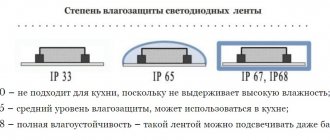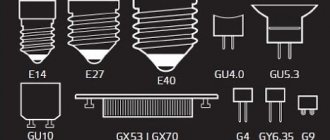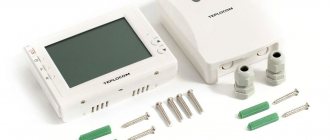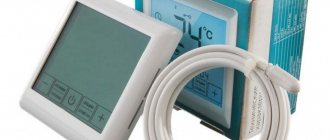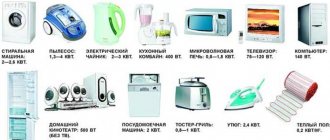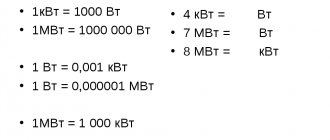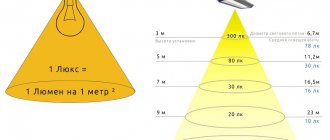Refrigerators have become a part of our lives. They help preserve the pristine freshness of products and preserve them as much as possible.
This is why most models are equipped with built-in freezers. It is customary to store meat and other products in them that spoil at high temperatures.
In this situation, much depends on the power of the freezer in the number of kW consumed per day. Payment for light also depends on the amount of electricity consumed, so the question of how many watts are consumed per day on average becomes especially relevant.
It’s all the more disappointing if the purchased equipment consumes too much energy, despite the fact that there are analogues in properties that are not inferior to your freezer, but cheaper, and whose consumption is several times lower.
Let's take a closer look at the types of freezers, average consumption rates, as well as the energy efficiency of each type of freezer.
Classification of energy consumption systems
As you know, the energy consumed is converted into kilowatts. The energy consumption level of freezers is divided into classes, which are designated by letter codes from A to G.
Recently, A++ class models have also come into widespread use. Some manufacturers, using additional thermal insulation, thus ensure more economical energy consumption.
In this case, the question arises which device is more economical. Here you should consider the average consumption for each type.
A typical cabinet-style freezer uses an average of 190 watts per hour. The No Frost system puts additional load on the compressor and also activates the fans, which also increases energy consumption.
The chest freezer is distinguished not only by its good capacity and affordable price, but also by its efficiency: the average energy consumption is approximately 80 watts per hour. Therefore, for those who are looking for an economical option, a chest freezer is best suited.
Classification of energy consumption type
How to choose an economical model
It is impossible to calculate the specific energy consumption of a refrigerator using bare data taken from technical documentation alone. Especially when we are talking about models from the budget and mid-budget segment. The number of kilowatts consumed is also influenced by the features of internal systems.
Factors responsible for energy consumption:
- compressor;
- cooling system;
- volume and number of chambers;
- tightness;
- additional functionality.
Important! Even such a convenient addition as a display adds tangible values to the total kilowatts. Not to mention modes like super freezing.
Compressor
On sale you can find models with one or two compressors. The latter offer more efficient control of temperature conditions - the number of modes and the speed of cold injection. Naturally, a tandem consumes much more electricity than a single unit.
As for the type of unit, inverter compressors are considered more economical . Such devices lower the temperature quite quickly and maintain the set values without much expense, smoothly adjusting the power.
Inverter compressors do not create serious loads on the network, operate relatively quietly and fail much less often than their analogues. Classic devices (stepped) always use full power both to increase the temperature and to maintain it.
Cooling system
Today's models operate on two technologies - NoFrost and a drip cooling system. In the latter case, the block with the evaporator is mounted on the rear wall of the refrigerator. Melted ice drops drop by drop onto a special tray and subsequently evaporates.
NoFrost technology works through dry freezing. That is, ice or frost does not form on the walls. The evaporation system is installed either behind the chambers or above the freezer. The liquid accumulated during operation is transported through gutters into a tray, after which it turns into steam. In this case, no forced defrosting of the refrigerator is required.
The drip system is more economical, while the NoFrost technology implies greater convenience, as well as several kilowatt-hungry fans and heating coils.
On a note! There are models where both systems work in pairs, complementing each other. This is a kind of compromise between ergonomics and energy saving.
Volume and number of chambers
The optimal solution for the average family of 3-4 people is a two-chamber refrigerator with a separate freezer. Models with one compartment will come in handy in a small kitchen. The more cameras and their volume, the higher the energy consumption. Therefore, when buying a refrigerator, it is more practical to take these parameters into account, rather than in reserve.
Tightness
Weak seals and mediocre thermal insulation of the housing contribute to the loss of cooled air. Poor sealing of the refrigerator means a constantly running compressor, and at the same time increased energy consumption.
Damaged rubber seal
Here it is better to give preference to proven brands. The model may be limited in functionality and other parameters, but well-known manufacturers never skimp on seals and insulation.
Annual energy consumption of the refrigerator
Such equipment works year after year and consumes expensive kilowatts day and night. The larger and more functional the equipment, the more electricity it consumes.
To calculate the annual consumption, it is necessary to clarify the power of the device or the peak load current. All data of this kind must be indicated in the instruction manual or brief specification, which is presented on the box.
If the documentation has not been preserved, then you can estimate the approximate consumption taking into account the energy saving class:
- A – 150-300 kW;
- B – 350-600 kW;
- C/D – 600-900 kW.
To calculate your energy costs, you need to multiply these figures by the current tariffs for your region. For example, if you have an A+ class refrigerator in a Moscow apartment, you will have to pay 807 rubles per year: 150 kW * 5.38 rubles. While for equipment of category B you will need to pay about 2000 rubles: 400 kW * 5.38 = 2152.
You can also calculate the annual consumption by knowing the load current. We calculate the power (amps * volts) and, taking into account the average operating time of the compressor per day (about 6 hours), we get an approximate value in kW. For example, 1.2 A * 220 V = 264 W = 0.26 kW. Next, 6 hours * 0.26 = 1.56 kW per day. We multiply the resulting figure by the number of days in a year, and then by the tariff (in our case for the capital - 5.38). In total, you need to pay 3063 rubles per year: 365 d * 1.56 kW = 569.4 kW * 5.38 = 3063.
Influence of third party factors
In addition to direct factors, there are indirect factors that affect energy consumption indicators. To eliminate them, it is necessary to create optimal operating conditions for the device. The features of the latter are mentioned in the manual.
Energy consumption also depends on:
- temperature in the room where the refrigerator is installed;
- cell congestion level;
- timely service;
- door opening frequency.
Temperature
The acceptable operating environment for most refrigerators is +20⁰С. If the thermometer drops closer to 0, then energy consumption will increase up to 1.5 times. Extreme heat also has a negative impact on efficiency. At +30⁰C, the refrigerator will consume almost twice as much energy as it should.
Camera workload
Manufacturers strongly do not recommend loading equipment, which is called “to capacity.” Moreover, it is better to arrange the products evenly rather than stack them in one compartment, especially if they are at room temperature.
Timely service
Here we are talking mainly about defrosting. If the device is not equipped with an automated melt ice removal system, then regular cleaning is extremely important. Snow crust in the chambers significantly reduces heat transfer qualities, thereby increasing energy consumption.
Snow coat in the refrigerator
Door opening frequency
An open door releases cooled air outside, increasing the temperature in the chambers: the compressor begins to work hard to bring in the cold and consumes energy.
Advice! When thoroughly loading or unloading the refrigerator, it is better to turn it off completely.
All of the above information will help you choose the most suitable refrigerator option, depending on the purpose of use, electricity consumption and freezing speed. You may also find information about the most reliable refrigerators useful.
TIPS - Operating the refrigerator - saving electricity
- If you are just choosing a refrigerator and looking at its energy consumption, then this is the right decision; when choosing a refrigerator, look at what energy consumption class it belongs to - A, A+ and A++ are best. Study the technical specifications and see how much it consumes in 1 year and approximately calculate it in rubles at your rate per kilowatt.
- If you have a single-tariff meter, then you can try installing a two-tariff meter that keeps track of the electricity spent per night and per day, at night the cost of electricity is several times cheaper, then in one day from 23.00 to 7 am, i.e. 8 hours, the refrigerator will work at the tariff, for example, is 1.5 rubles per kilowatt. per month we get 8*30 days 240 hours of work at a lower rate and per year up to 2880 hours. The savings per year will be ~ 480 rubles.
- You go to the refrigerator but don’t know why, maybe you don’t want to eat, and if you do, first try to think about what you want to cook and immediately open it and take it without standing with the door open.
These small but at the same time effective tips will help you save on electricity.
What determines energy consumption?
When purchasing a new device, you should study the instructions, which indicate the capacity of the refrigerator.
If you purchase the brand with the lowest consumption, you can significantly reduce your electricity bill. Electricity consumption depends on the consumption class. This parameter is set during the manufacture of the device. However, other factors also influence energy consumption.
Parameters that affect electricity consumption include:
- Number of cameras. Single-chamber ones are considered cost-effective. But for farming, a two-chamber apparatus is considered optimal;
- The size of the cameras affects performance. Flow increases with increasing internal volume;
- Number and type of compressors. Two-compressor engines are more voracious;
- Availability of functions. The more sophisticated the device, the higher the consumption;
- Tightness. The better the thermal insulation and tightness, the longer the cold remains inside;
- Cooling system. Modern industry produces two types - drip and NoFrost (without frost formation). There are also models with a combined system. The drip-cooled design is more economical than its competitors.
From the above, it is clear that the power consumption of a refrigerator can change significantly upward as its functions increase.
What is the compressor power of a domestic refrigerator?
The average power of a refrigerator ranges between 100 and 200 W/hour (at rest), the maximum is 300 W/hour (while the compressor is running), that is, the average is about 250 W. Do not forget that a refrigerator that is plugged in 24 hours a day runs periodically.
Interesting materials:
How to neutralize ammonia in water? How should you save water at home? How should distilled water be stored? How to disinfect drinking water? How to disinfect river water? How to explain how a phraseological unit has sunk into the water? How can you explain that you won’t spill it with water? How to treat a water tank from rust? How are water drops formed? How to freeze water very quickly?
What are the classes?
An inexperienced consumer can easily get confused about energy efficiency classes. Moreover, the instructions were revised more than once, becoming more complicated each time. Since 2014, amended standards have been in force, dividing devices into classes (table below).
The table shows that the higher the class, the lower the percentage value of the index, and at the same time the energy consumption of the model.
Important! This gradation applies exclusively to refrigerators and free-standing freezers. Other equipment (washing machines, split systems, etc.) operates with different indicators.
Class A
A little earlier, equipment was classified by letters from A to G. Over the last ten years, even more economical products with a reduced index have appeared. Therefore, pluses began to be added to the letter A - from one to three. Models with this index today occupy almost two-thirds of the entire refrigeration market.
It turns out that equipment in the same category can have completely different energy efficiency. That is, Class A refrigerators are considered energy-saving, while A+++ devices are more than twice as superior to them in this regard: 50% versus 22% (see table).
BG classes
There are still equipment on sale with energy efficiency class B-D. But in five to ten years no one will remember about them, as happened with the EG category models. Naturally, it is not advisable to buy a refrigerator with a high energy efficiency index (B or C).
Advice! The best option for the budget and mid-budget segment is A+ or A++. Almost all premium models come with the prefix A+++.
How to calculate consumption
All information about the power and resource costs of the refrigeration unit is indicated in the technical passport. Most often, consumption information is located in the energy saving section and is indicated in kWh/year. Knowing these data, it will not be difficult to calculate how much the refrigerator consumes per month, per day, and even per hour. You just need to perform a few simple mathematical operations.
For example, there is an A++ class refrigerator with a consumption of 220 kWh/year. To find out the monthly resource consumption: 220/12=18.3 kWh. We calculate the daily consumption in the same way: 220/365 = 0.603 kW. You can find out how much the refrigerator consumes per hour in watts: (0.603/24)*1000=25.25 W.
All calculations show average values and may change under the influence of various factors. Also, the calculations do not take into account engineering error.
Comparison with other household appliances
It is believed that large household appliances consume more electricity than small ones. But it is not always the case. Energy consumption depends on the power of the device and its operating time.
If we compare average values, refrigeration equipment with a high energy saving class will be more economical than many other kitchen units. For example, a standard 2 kW electric kettle uses about 28 kWh monthly. A class A refrigerator is about 19 kWh. If you use a computer 3-4 hours a day, then up to 60 kWh will be used up in a month. The consumption of a washing machine will be approximately the same.
Freezer control system
Freezers can be controlled using mechanical or electronic switches. The first ones are convenient because the mechanism is quite easy to master, and the likelihood of equipment failure is extremely low.
In the first case, control is carried out using switches and taps. Most of these devices are equipped with panels with recessed buttons. The image shows the main buttons and indicators.
Control Panel. 1 – quick freezing. 2 – indicator. 3 – temperature indicator, turns on when a problem occurs. 4 – this light turns on when the device is operating normally. 5 – mechanical regulator
The electronic system is most often equipped with the same buttons, but some models also have a display that reflects the current state of the equipment. More advanced machines are equipped with touch-sensitive mode switching mechanisms. With this switching, it is much easier to choose the optimal mode for freezing food and set the desired temperature.
Indicator diagram
Dishwasher
Together with a kettle and an electric stove, the dishwasher is one of the three most “gluttonous” kitchen inhabitants. She has to heat the water and work for a long time; this cannot be done without a large amount of energy.
So, let's do the math. Dishwasher usage is directly related to how much you use your stove and how much you cook. If you mostly eat out and at home only have breakfast and a light snack in the evening, then you can run the dishwasher only once a day, or even every other day. If you have children and have to cook a lot, then the dishwasher will work at least 2 cycles per day.
Let's calculate the consumption for one full cycle per day. It takes on average 2.5 hours. Dishwashers differ in the number of sets of dishes washed in 1 cycle. It could be 6 sets, maybe 9-12. Let's take the second option.
Such a machine will consume from 0.8 to 0.95 kWh per cycle. Per month - from 24 to 28.5 kWh.
Expert opinion
Viktor Pavlovich Strebizh, lighting and electrical expert
Any questions ask me, I will help!
How often the doors are opened and how long they remain open directly determines how many watts your refrigerator consumes. If there is something you don’t understand, write to me!
What is important to consider when taking measurements
When calculating energy consumption, it is necessary to remember that many different factors influence the operation of the refrigerator.
For example, due to different indoor temperatures, the amount of energy consumed in the summer months may differ from that consumed in the winter.
In addition, the operation of the device may be affected by the following:
- quality, color and density of the materials from which the device is made;
- frequency of door opening and closing;
- use of additional functions such as ice dispensing, lighting, etc.;
- quantity of stored products.
Even though the refrigerator runs constantly, it consumes a relatively small amount of energy. Those who want to save as much as possible on costs should carefully choose a cooling device. Thanks to special markings on the devices, choosing the right device will be easy.
